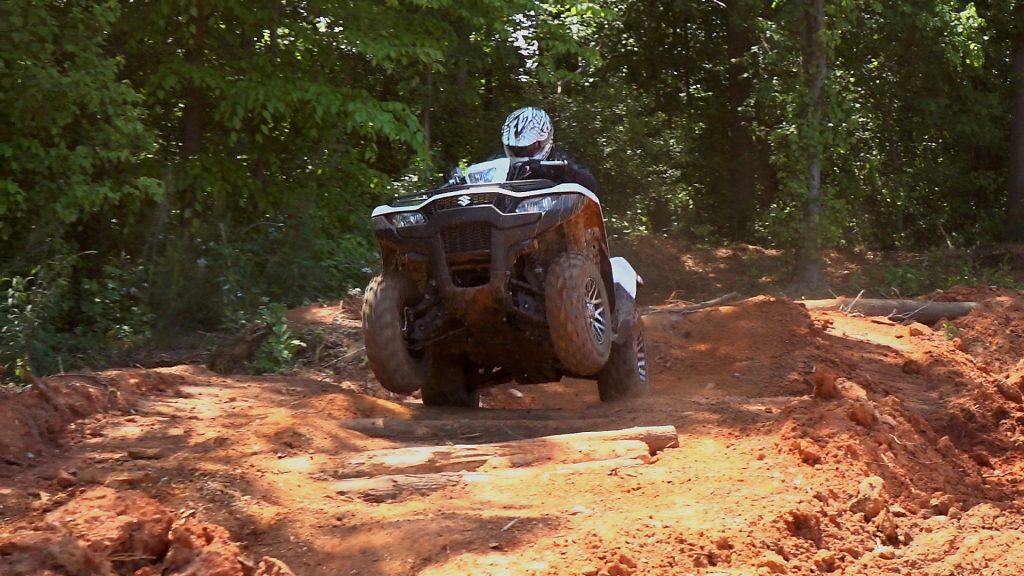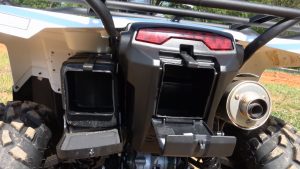2019 Suzuki KinQuad 750 Test Review: WITH VIDEO
Suzuki packs a decade of updates into the 2019 KingQuad 750 and 500
Suzuki is responsible for many firsts in the powersport’s industry. In 1983, Suzuki changed the shape of ATVs forever with the four-wheeled QuadRunner 125. In 1985, they created the high-performance, sport quad segment introducing QuadRacer LT250R. In 1987, the 246cc QuadRunner 4wd offered Independent rear suspension and the flexibility of two and four-wheel-drive with a lockable front differential. A multi-range transmission added to the machine’s versatility. Building on the success of the QuadRunner 4wd, the KingQuad lineage began with the introduction of the legendary KingQuad 300 in 1991.

Suzuki recently invited us out to the motocross practice facility of Joe Gibbs Racing in North Carolina, to put the 2019 power steering and non-power steering equipped KingQuad 750 through a hard day’s use
After a brief absence from Suzuki’s lineup, the KingQuad returned in 2005 as the automatic transmission equipped KingQuad 700, generating a lot of excitement among enthusiasts. The 700 grew into the 750 and power steering was added in 2009. 2016 brought about minor styling updates and the bodywork was modified allowing easier access to the oil filter and dipstick. The rev limiter in 4wd with differential lock engaged became speed sensitive versus RPM sensitive for increased wheel speed to conquer challenging mud.
For 2019, Suzuki has once again dusted off the venerable KingQuad 750 and 500 adding the most significant round of updates since the addition of power steering in 2009. Complementing significantly modernized styling, for 2019, Suzuki made a number of changes to the ATV looking to enhance its overall performance and durability, while seemingly making minimal changes in the production process in their Rome, Georgia facility where the KingQuads are manufactured.
Suzuki recently invited us out to the motocross practice facility of Joe Gibbs Racing in North Carolina, to put the 2019 power steering and non-power steering equipped KingQuad 750 through a hard day’s use on some freshly-cut, loamy trails, and a log strewn obstacle course. Of course, we also had to take a couple laps around Joe Gibbs’ supercross and motocross practice tracks.
Engine
The KingQuad 750 is powered by a 722cc, four-valve, double overhead cam, four-stroke engine featuring Suzuki fuel injection. The cylinder is canted forward 48 degrees allowing for a lower seat height and center of gravity. The 4.6gal fuel tank is mounted under the seat, adding to the low CG. The engine is mated to an automatic CVT transmission with high and low forward ranges, neutral and reverse selected by a smooth, precise, gated shifter. The drive system features two and four-wheel-drive with a lockable front differential, selected by a right side handlebar mounted, push-button and lever combo.

New fuel mapping for 2019 keeps the KingQuad’s emissions EPA and California compliant, and is said to improve overall performance. The clutch was recalibrated to deliver more power at all throttle settings.
New fuel mapping for 2019 keeps the KingQuad’s emissions EPA and California compliant, and is said to improve overall performance. To accommodate the machine’s 330 pound towing capacity increase and improve overall riding performance, the clutch was recalibrated to deliver more power at all throttle settings. The weights, springs, and driven pulley ramp were changed in search of smoother initial engagement at a higher RPM, increased RPMs on top, and improved engine braking performance.

Suzuki added a piston oil jet to the crankcase. It sprays oil on the underside of the piston increasing cooling and lubrication for improved durability.
Expected to work harder, Suzuki added a piston oil jet to the crankcase. It sprays oil on the underside of the piston increasing cooling and lubrication for improved durability. Providing increased oil output for the piston cooling jet and aid in general engine lubrication, the oil pump’s main rotor thickness was increased from 8mm to 10mm boosting pump output from 7.6 to 9.5 liters per minute.

We drag raced a 2018 and 2019 several times with mixed results. While the 2019 doesn’t appear more powerful than the 2018 KingQuad, the combination of the clutching and new fuel mapping make the engine a bit snappier and responsive to throttle inputs in addition to adding a few more RPMs off the bottom for easier towing.
The engine fires up and warms quickly with no quirks, emitting a well-muffled, yet strong sounding, throaty roar from its stainless steel exhaust. Engine performance is refined and subtly improved. Accelerating from a dead stop or out of a corner at slower speeds, the engine starts pulling smoothly at a slightly higher RPM. Casually cruising along or romping the gas, the engine seems to continue spinning a bit higher in the RPMs than years past. We drag raced a 2018 and 2019 several times with mixed results. While the 2019 doesn’t appear more powerful than the 2018 KingQuad, the combination of the clutching and new fuel mapping make the engine a bit snappier and responsive to throttle inputs in addition to adding a few more RPMs off the bottom for easier towing.
The engine runs clean throughout the RPM range with no annoying popping or sputters. Low-end power is good and very manageable in technical terrain. When the trail opens up or gets steep, the power builds seamlessly into a respectable midrange and top-end. While it lacks the sheer power of the big-bore twins on the market power is adequate for almost any use and far easier to deal with on long rides, Power is ideal for hunting, hauling, or spirited exploring. In its early years, King Quad even won its class in the 12 Hours of ATV America endurance race, proving its toughness.

When the trail opens up or gets steep, the power builds seamlessly into a respectable midrange and top-end.
On downhills, engine braking is smooth and natural feeling, without the sometimes overly aggressive feeling and excessive drivetrain chattering we’ve become accustomed to on a lot of Polaris units we’ve tested.
Handling and Suspension

While the frame’s geometry remains unchanged, Suzuki made a number of changes to the frame to increase strength, rigidity, and towing capacity.
While the frame’s geometry remains unchanged, Suzuki made a number of changes to the frame to increase strength, rigidity, and towing capacity. The thickness of the mainframe tubes have been increased by .4mm from 1.6 to 2mm. The mounting brackets for the suspension and final drive cases were reinforced. The KingQuad’s rear ball mount has been replaced by a 2” hitch receiver, which along with the reinforced frame allow for the 330 pound increase in towing to 1323 lbs.

New gas-charged shocks feature larger shock bodies and five-way preload adjustment all around. The front is said to have improved damping settings for better control.
Riders have complained of over-steering on previous models that could make the machine a handful on rough downhills or in rough terrain at high speeds. This was far more pronounced on non-power steering equipped models. For 2019, Suzuki says, “The base steering characteristics are now tuned for a under-steer condition.” With no specified front-end geometry changes, Suzuki must have worked to accomplish this with shock and sway bar updates.

Suzuki utilized a larger diameter rear sway bar with a different shape to increase its rigidity and effectiveness. Softer sway bar bushings were used to reduce shock transmission into the chassis.
New gas-charged shocks feature larger shock bodies and five-way preload adjustment all around. The front is said to have improved damping settings for better control. The suspension geometry remains the same with dual A-Arms up front delivering 6.7” of travel and dual arm rear suspension providing 7.7” of travel, which are somewhat modest numbers these days.
Suzuki utilized a larger diameter rear sway bar with a different shape to increase its rigidity and effectiveness. Softer sway bar bushings were used to reduce shock transmission into the chassis. To further improve control, Suzuki increased the power steering’s electrical power output by 40% in search of lighter steering and reduced bump feedback.
The quad rolls on 25×8-12 front and 25×10-12 rear Carlisle tires mounted on cast aluminum wheels on the SE models or steel wheels on the other models.
The KingQuad is a claimed 47.8” wide with a 50.6” wheelbase, 36.2” seat height, and 10.2” of ground clearance putting its size somewhere in the middle of the class. A claimed curb weight of 721 pounds is respectably light for a big 4×4.

At slow to intermediate speeds, its quick, nimble handling lets you bob and weave through tight sections of trail.

EPS adds a lot to the KingQuad’s handling, rider control, and will definitely reduce fatigue. If you’re considering a KingQuad, we strongly recommend going with a power steering equipped model.
The updated chassis and suspension retain what was great about the KingQuad’s handling. At slow to intermediate speeds, its quick, nimble handling lets you bob and weave through tight sections of trail. Steering is light in 2wd becoming a bit stiffer in limited slip 4wd on the non EPS model, and even more so with the differential lock engaged. The power steering equipped model only becomes notably stiffer when the front differential is locked, common on all standard 4wd, EPS equipped ATVs we’ve tested. We couldn’t tell much difference between the 2018 and 2019 EPS performance, although EPS adds alot to the KingQuad’s handling, rider control, and will definitely reduce fatigue. If you’re considering a KingQuad, we strongly recommend going with a power steering equipped model.

The revised shocks, and stiffer sway bar result in a mildly calmer KingQuad when things get rowdy without sacrificing plushness at lower speeds.
The revised shocks, and stiffer sway bar result in a mildly calmer KingQuad when things get rowdy without sacrificing plushness at lower speeds. The shocks are similar to their older counterparts when it comes to eating up roots, rocks, and other small trail junk while cruising along. On big g-outs and jump landings, the new shocks don’t bottom as easily and seem a bit more composed under braking and on downhills. When speeds pick up, both rear tires are a bit more planted in corners, with less front-end dive entering turns and on off-camber, descents.

On big g-outs and jump landings, the new shocks don’t bottom as easily and seem a bit more composed under braking and on downhills.

When speeds pick up, both rear tires are a bit more planted in corners, with less front-end dive entering turns and on off-camber, descents.
The KingQuad’s handling is well matched to its intended use of working hard and trail riding with just a bit more predictability when getting aggressive. If you like to ride your 4×4 like a sport quad, you will be looking for aftermarket front A-Arms with more caster to trade in some quick steering manners for a bit more high-speed predictability.
Brakes
Braking has been updated for 2019. The dual hydraulic front disc brakes received new pads, and the lever and line were optimized for better feel. The low maintenance, sealed, multi-disc, rear brake received a revised lever ratio for improved feel and overall performance. Braking power was good at both ends. The front brakes offered good feel through the lever, but the rear brake still lacks the positive feel of standard disc brakes although we could lock it up on demand. The overall difference in braking is minimal while its performance is more than adequate.

The floorboard and tall footpeg combination is the best in the business with plenty of room to pivot your foot on the peg in rough terrain
Ergonomics
To complement its revised power steering, Suzuki utilized a taller handlebar, putting the rider in a more relaxed position. We found the new bar height comfortable and easy to work with. We’ve always been big fans of Suzuki’s plush, easy to move around on, T-shaped seat. Their floorboard and tall footpeg combination is the best in the business with plenty of room to pivot your foot on the peg in rough terrain, even with a little mud build up. The rear brake pedal height is also right where it should be.

To complement its revised power steering, Suzuki utilized a taller handlebar, putting the rider in a more relaxed position. We found the new bar height comfortable and easy to work with.
Utility
Steel racks are still the best design in the industry, in our opinion, when it comes to securing cargo, and they don’t crack in cold temperatures. The KingQuad’s racks feature a wrinkle black paint finish and are rated to haul 66lb front and 132lb rear. The KingQuad’s work capabilities have been taken up a notch for 2019. The new hitch receiver, accompanying frame reinforcements, and clutching changes helped facilitate the KingQuad’s 330lb towing capacity increase to 1323lbs. A new, rear mounted, centrally mounted, 4.0 liter storage box sits adjacent to the left side mounted 4.0 liter storage box in addition to the 2.8 liter water resistant storage box located on the right front fender.

The new hitch receiver, accompanying frame reinforcements, and clutching changes helped facilitate the KingQuad’s 330lb towing capacity increase to 1323lbs.
Styling and other Details
Accompanying the new styling is the wise return of the handlebar mounted headlight. A revised digital instrument display now features a programmable service interval reminder. Easing maintenance, Suzuki made changes to the bodywork back in 2016 adding easier access to the oil fill point and dipstick. For 2019, the electronic panel under the seat can be easily removed in under a minute, providing easy access to the fuel filter.
Conclusion
While the KingQuad is not an all-new machine, Suzuki obviously did some work building on what riders liked about the 500 and 750 while making some effort to minimize its shortcomings. The updated KingQuads should work harder and last longer than ever, which is great considering those are two of the biggest reasons enthusiasts would consider the machine. For recreational trail riding, the updates provide a mild improvement in engine performance and handling prowess although the sport 4×4 fans in us wanted a bit more.

If you were a fan of previous models then Suzuki has given you a bit more of an excuse to pull the trigger on a new ATV.
For 2019, Suzuki has not redefined what the KingQuad 750 is best suited for. If you were a fan of previous models then Suzuki has given you a bit more of an excuse to pull the trigger on a new ATV.
Manufacturer: Suzuki
Model: 2019 KingQuad 750 Power Steering SE
MSRP: $9,899
2019 Suzuki KingQuad 750 Ratings
Summary: While the KingQuad is not an all-new machine, Suzuki obviously did some work building on what riders liked about the 500 and 750 while making some effort to minimize its shortcomings. The updated KingQuads should work harder and last longer than ever, which is great considering those are two of the biggest reasons enthusiasts would consider the machine. For recreational trail riding, the updates provide a mild improvement in engine performance and handling prowess although the sport 4x4 fans in us wanted a bit more. For 2019, Suzuki has not redefined what the KingQuad 750 is best suited for. If you were a fan of previous models then Suzuki has given you a bit more of an excuse to pull the trigger on a new ATV.
















